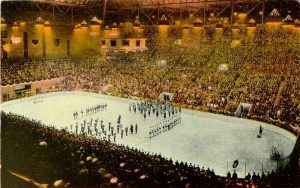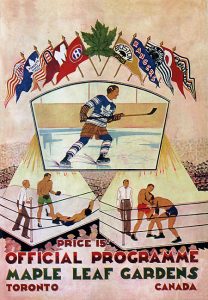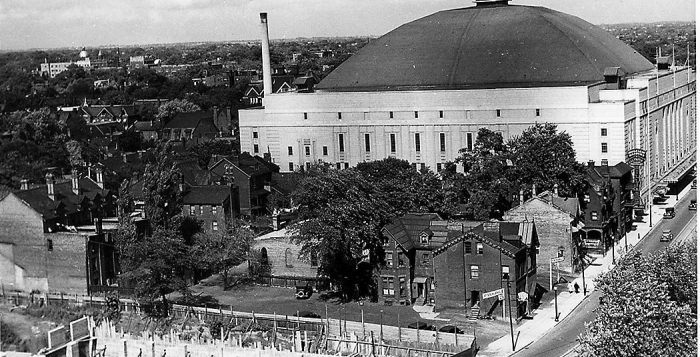This Day in Hockey History – November 12, 1931 – Maple Leafs in the Gardens
(Photo: [Public domain], via Wikimedia Commons)
Hockey teams and their fans grow out of their arenas. This happened to the Toronto Maple Leafs, so they moved into their new Maple Leaf Gardens on November 12, 1931. There they stayed for almost 70 years before again needing an upgrade.
Toronto NHL teams skated at Arena Gardens on Mutual Street from 1917 to 1931. However, it only had the capacity for 8,000 seats and lacked modern amenities. With these drawbacks, Conn Smythe explained, “As a place to go all dressed up, we don’t compete with the comfort of theatres and other places where people can spend their money. . . . We need at least twelve thousand seats, everything new and clean, a place that people can be proud to take their wives or girlfriends to.” As the 1920s ended, Smythe also pushed for a reliable heating/cooling system, a public address system, and broadcast capabilities.
To build a new rink during the Great Depression, Smythe needed to find about $1.5 million in funds and a site appealing to paying fans. Smythe and fellow executives (of Maple Leaf Gardens Limited) convinced local business leaders to invest amid questions of “Don’t you know there’s a depression on?” When that still left them $25,000 short of the lowest construction bid, business manager Frank Selke made an offer to local labor unions. Those who worked on the Gardens would receive 20% of their paycheck in stocks, and as it turns out, those workers (about 700 men) would have profited when the stock prices jumped from 50 cents to 100 dollars by the mid-1940s. With the finances coming together, Smythe was able to convince Eaton’s department store to sell their land on the corner of Carlton and Church Streets, right by the streetcar that would bring in the fans.
Constructing the new arena only took about five months. They began on June 1, and Ontario Lieutenant-Governor W.D. Ross laid the cornerstone on September 21. Ross called Toronto a sports center and the “logical location for a building worthy of our record, of current need and of our ambition.” The architectural firm of Ross & Macdonald designed with Art Deco and Art Moderne styles that did not require columns throughout the interior that would have obstructed some views. Thomson Brothers of Toronto used three steam shovels, two concrete mixing plants, 77,500 bags of concrete, 1.5 million bricks, 13,000 tonnes of steel, and over 1,200 laborers to build the Gardens.

[Public domain], via Wikimedia Commons

By Toronto Maple Leafs, via
Wikimedia Commons
The mayor performed the ceremonial puck drop, and the players, Red Horner and Mush March, reenacted the face-off in 1999, at the last game played at Maple Leaf Gardens. Overall, Smythe found the opening “pretty much as I had imagined it in my rosiest dreams.”
The game itself did not turn out perfectly rosy. March scored for the Black Hawks early on before Charlie Conacher scored the first Maple Leafs’ goal in the new arena. The home team outshot their visitors, but even an arm injury (causing a 15 minute delay) did not stop opposing goalie Chuck Gardiner from blocking all other shots. Vic Ripley scored the final goal of the game for the Black Hawks, so the Maple Leafs lost 2-1. All in all, the building received rave reviews, and at the end of the season, the captain’s prediction proved true when the Maple Leafs brought home the Stanley Cup.
In addition to hockey (of all levels), the Gardens hosted boxing and wrestling matches and various concerts and performances. After their last game, February 13, 1999 (fittingly against Chicago), the Maple Leafs moved into Air Canada Centre. The following November, the Gardens closed to the public, but a complete revitalization was completed in 2012. The arena was awarded the Heritage Toronto Award of Merit and named a National Historic Site of Canada. Heritage Toronto presented a plaque on November 13, 2013 so that future generations will understand the vital place Maple Leaf Gardens has held in Toronto.















[…] his retirement. Owner Conn Smythe credited Clancy with bringing in the ticket sales helping keep Maple Leaf Gardens going, and Clancy helped them win the Cup in 1932. Clancy was only 5-foot-7 and about 155 pounds […]